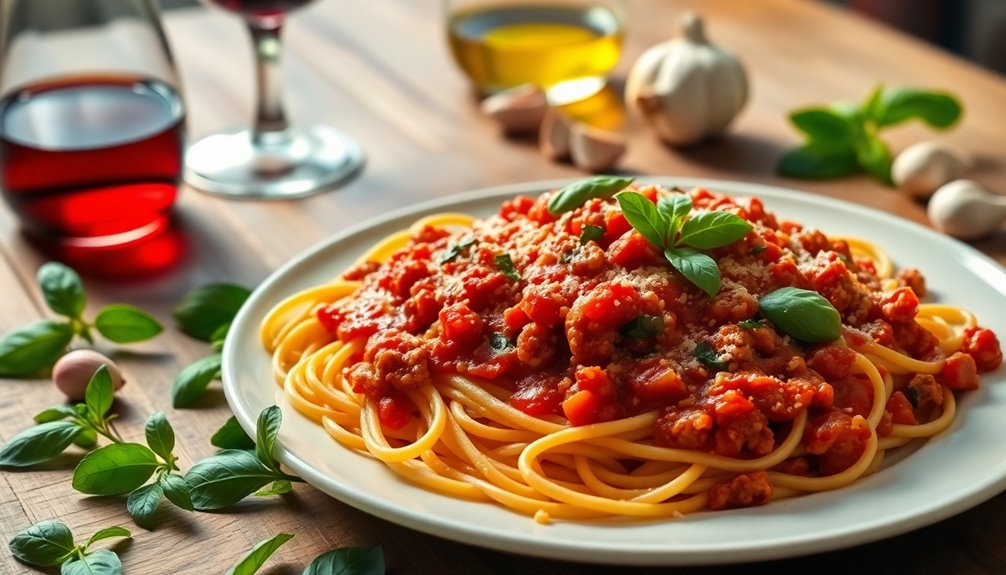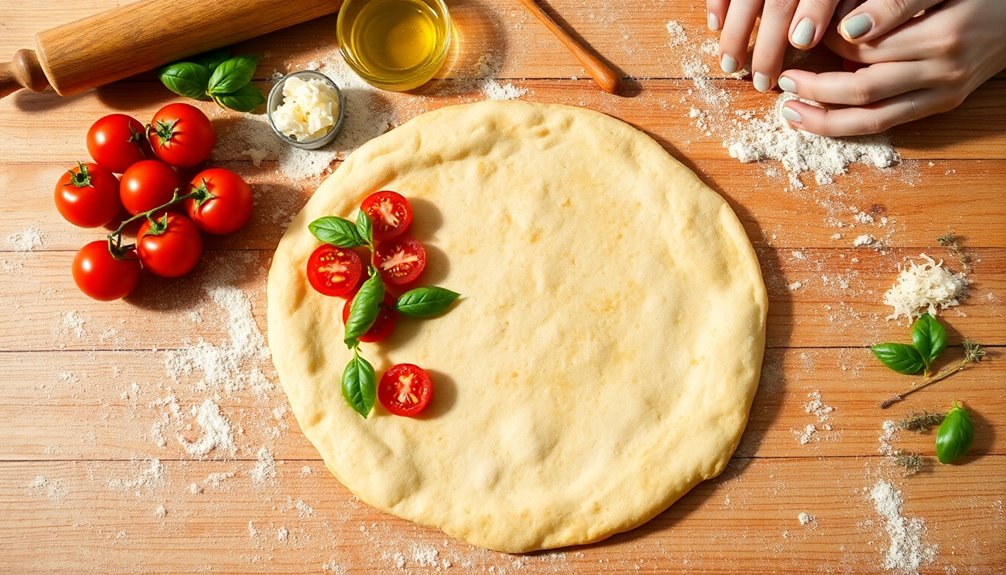When you're crafting a spaghetti sauce, you might think it's just about throwing ingredients together, but there's much more to consider. You'll want to start with the right base, perhaps sautéing onions and garlic in olive oil for that perfect aromatic foundation. As you layer flavors, think about how a splash of red wine or a hint of fresh basil could elevate your sauce. But what's the secret to achieving that authentic taste that keeps everyone coming back for more? Let's explore the nuances that can transform your sauce from ordinary to extraordinary.
Key Takeaways
- Sauté onions and garlic in olive oil, then add diced bell peppers for enhanced flavor before incorporating crushed tomatoes.
- Simmer the sauce for at least 30 minutes to develop rich flavors, adjusting seasoning as needed.
- Use essential ingredients like ground beef, crushed tomatoes, garlic, onion, and dried herbs for a traditional taste.
- Customize the sauce with red wine, sugar, or additional vegetables based on personal preferences.
- Serve the sauce over pasta, or use it as a base for pizza, lasagna, or casseroles, garnishing with herbs or cheese.
History
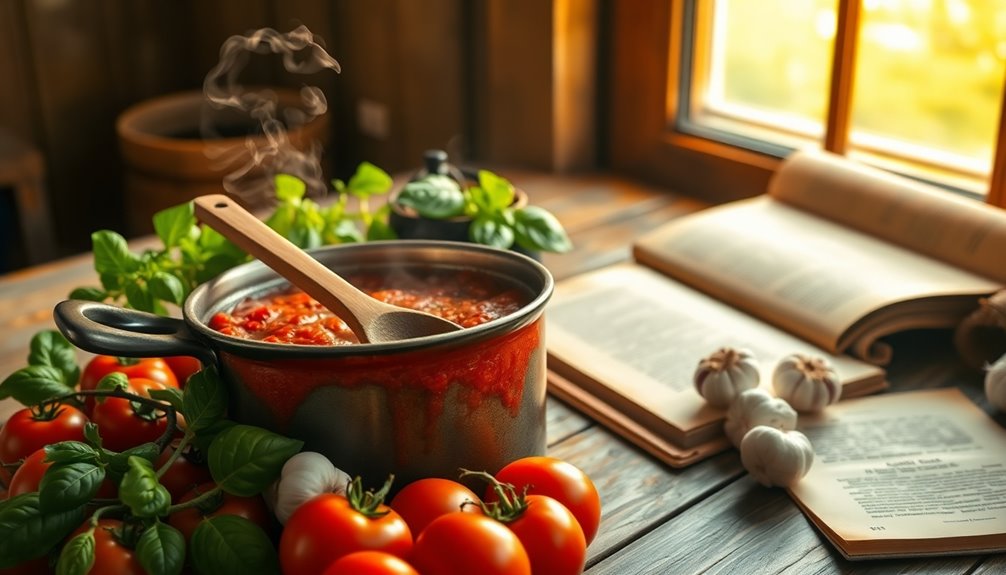
The history of spaghetti sauce is as rich and flavorful as the dish itself, rooted in the culinary traditions of Italy. The origins trace back to the 16th century when tomatoes were first introduced after Spanish colonization.
Initially, pasta topped with various ingredients was common, but the 19th century saw a shift with tomatoes becoming a staple in sauces, particularly in southern Italy.
Marinara, a classic red sauce, emerged from Neapolitan cuisine, showcasing simple ingredients like tomatoes, garlic, and herbs.
As Italian immigrants brought their culinary traditions to America in the late 19th century, spaghetti and meat sauce gained popularity.
The commercialization of spaghetti sauce began in the early 20th century, with brands like Ragu and Prego making Italian flavors widely accessible.
Recipe
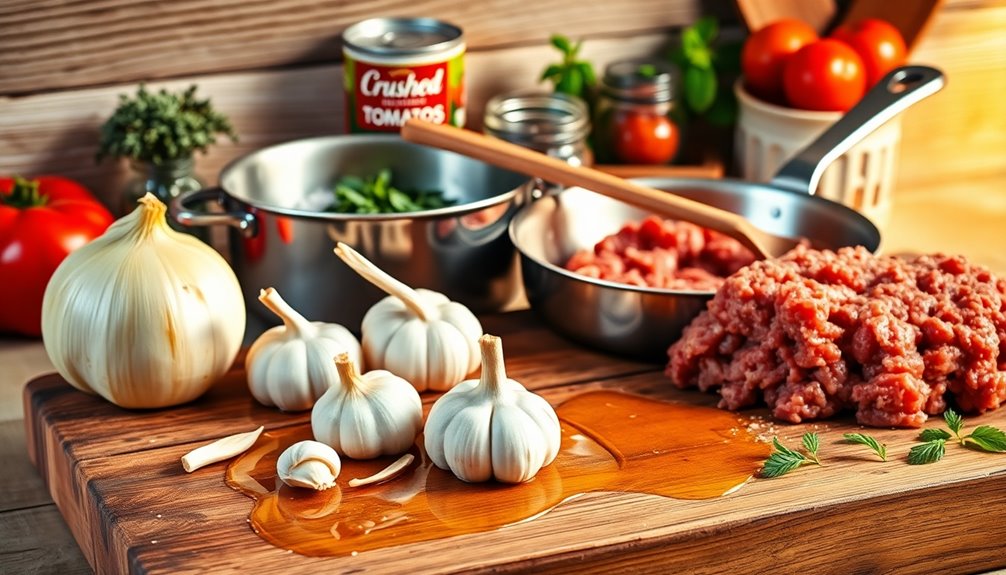
Spaghetti Sauce Recipe
Making a delicious spaghetti sauce at home is both simple and rewarding. This classic recipe will fill your kitchen with enticing aromas and provide a comforting dish that can be enjoyed by the whole family. With just a handful of ingredients, you can create a sauce that's rich in flavor and perfect for tossing with your favorite pasta or using as a base for other Italian dishes.
The key to a great spaghetti sauce lies in allowing the flavors to meld together through careful cooking and simmering.
To begin, gather your ingredients and prepare your workspace. The process is straightforward and requires minimal prep time, making it an excellent choice for weeknight dinners or meal prepping. This sauce can also be easily customized with additional spices or vegetables, depending on your taste preferences.
Once you've mastered this basic recipe, feel free to experiment with different variations to create your own signature sauce.
Ingredients:
- 1 pound ground beef
- 1 medium onion, chopped
- 2 cloves garlic, minced
- 1 can (28 ounces) crushed tomatoes
- 1 tablespoon dried oregano
- 1 tablespoon dried basil
- Salt and pepper to taste
- Olive oil (for sautéing)
Cooking Instructions:
In a large skillet or saucepan, heat a splash of olive oil over medium heat. Add the chopped onion and minced garlic, sautéing until the onion becomes translucent and fragrant.
Next, add the ground beef, breaking it up with a spatula as it cooks until browned. Once the meat is fully cooked, drain any excess fat and stir in the crushed tomatoes, oregano, basil, salt, and pepper.
Bring the mixture to a gentle simmer, then reduce the heat to low and let it simmer for at least 30 minutes, stirring occasionally to prevent sticking and allow the flavors to develop.
Extra Tips:
For an even deeper flavor, consider simmering the sauce for longer than 30 minutes—up to an hour if you have the time.
You can also add a splash of red wine or a pinch of sugar to balance the acidity of the tomatoes. If you'd like to incorporate vegetables, diced bell peppers or mushrooms can be sautéed alongside the onions.
Finally, don't forget to taste the sauce as it cooks, adjusting the seasoning to your preference. Leftovers can be refrigerated for up to 4 days or frozen for 4-6 months, making this sauce a great option for meal prep!
Cooking Steps
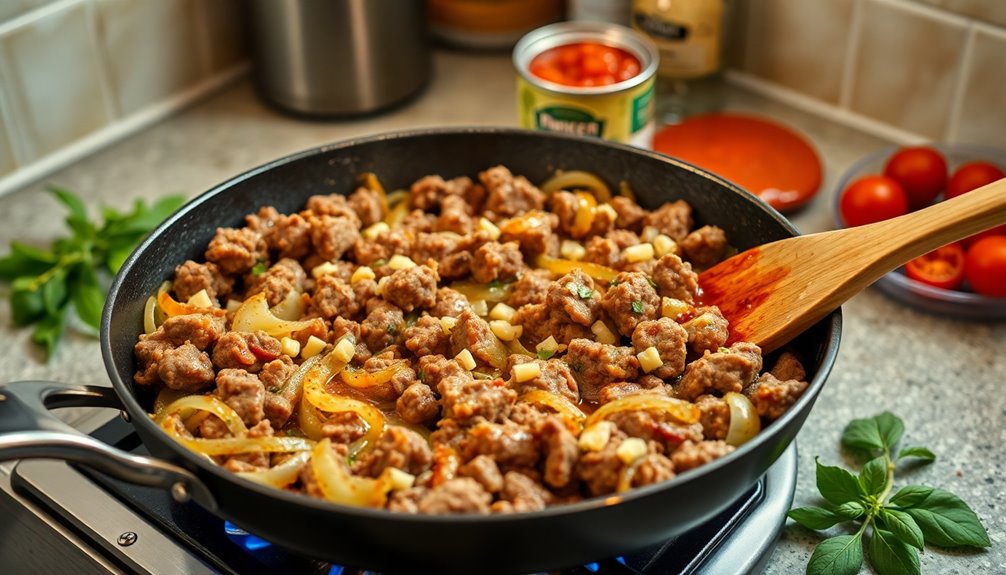
To make your spaghetti sauce shine, start by sautéing onions and garlic until they're soft and fragrant.
Next, add in some diced bell peppers for extra flavor and color.
Once that's done, stir in the crushed tomatoes and let everything simmer to develop those delicious tastes.
Step 1. Sauté Onions and Garlic

Start by heating 1 tablespoon of extra virgin olive oil in a large pan over medium heat until it shimmers. This will help release the flavors of the onions and garlic.
Next, add 1 medium yellow onion, finely chopped, and sauté for about 5 minutes until the onions become translucent and tender.
Then, incorporate 3-4 minced garlic cloves into the pan. Cook for an additional 30 seconds until fragrant, but be careful not to burn the garlic, as it can turn bitter.
Stir continuously to ensure even cooking and prevent sticking. This mixture will develop a rich aroma, forming the flavorful base for your spaghetti sauce.
Enjoy the delightful scents as they fill your kitchen!
Step 2. Add Diced Bell Peppers
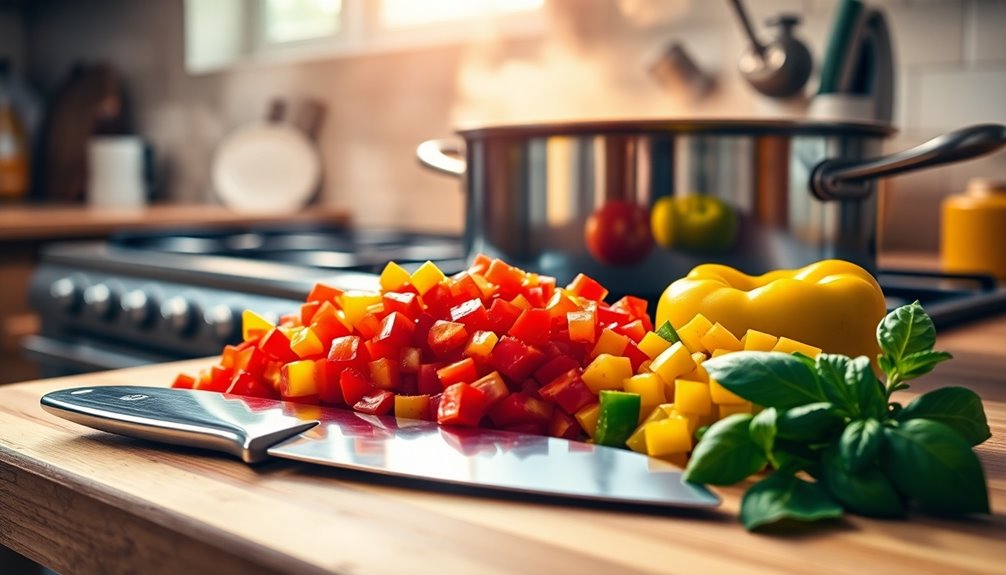
Add about 1 to 2 cups of diced bell peppers to your sautéed onions and garlic for a burst of flavor and color.
Start by sautéing the bell peppers in olive oil along with the onions and garlic for about 5 minutes until they're tender and fragrant. Mixing red, yellow, and green bell peppers not only enhances the sauce's flavor but also makes it visually appealing.
These diced bell peppers add sweetness, texture, and important vitamins A and C, boosting the nutritional value of your spaghetti sauce.
After adding them, let your sauce simmer for at least 30 minutes. This allows the flavors to meld beautifully, creating a delicious and hearty base for your favorite pasta dish.
Step 3. Stir in Crushed Tomatoes
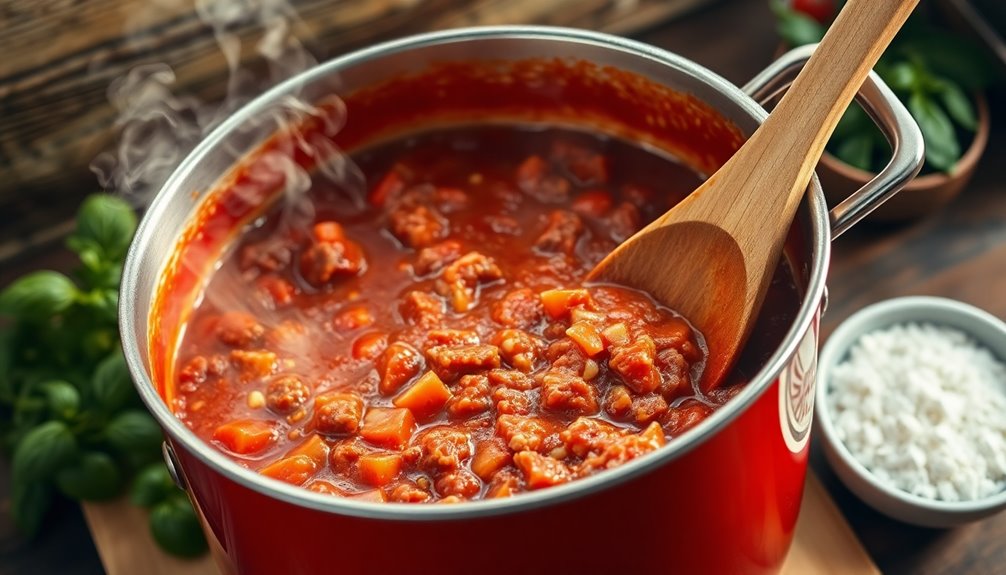
Stirring in a 28-ounce can of crushed tomatoes transforms your sautéed aromatics into a rich, flavorful base for your spaghetti sauce.
After you've cooked the garlic and onions until they're fragrant, add the crushed tomatoes directly to the pan. This step is crucial, as the tomatoes meld with the aromatics, enhancing the overall flavor.
Don't forget to incorporate your seasonings at this stage; they'll further enrich the sauce. You may want to adjust the consistency by adding a bit of water, depending on how thick you like your sauce.
As the crushed tomatoes begin to simmer, the aroma fills your kitchen, signaling that your spaghetti sauce is on its way to becoming a delicious meal. Additionally, using fresh herbs like basil can elevate the flavor profile of your sauce.
Step 4. Simmer for 30 Minutes
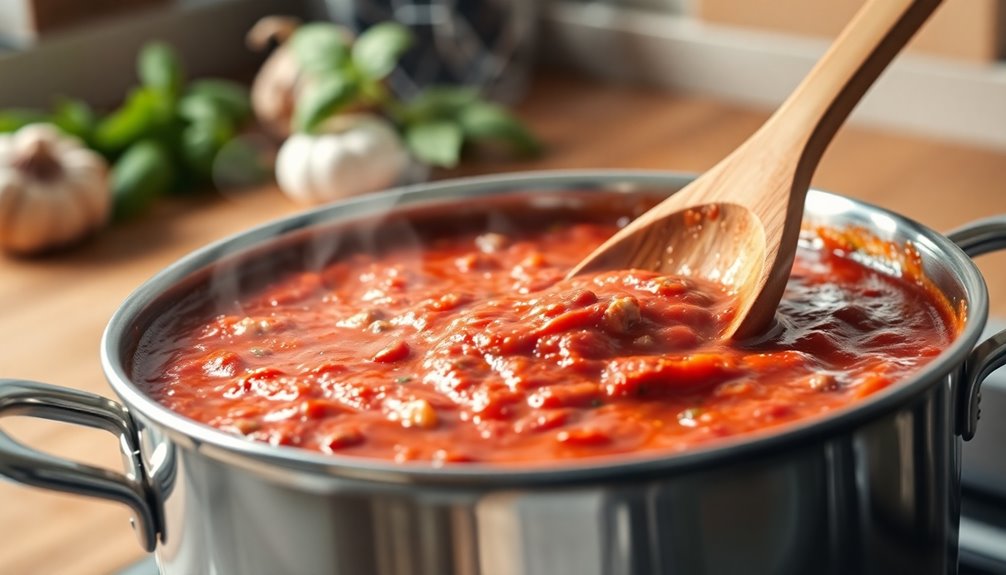
Simmering your sauce for at least 30 minutes is essential for developing rich, harmonious flavors. During this simmering process, the sauce thickens as excess liquid evaporates, resulting in a more concentrated and aromatic dish.
Stir the sauce occasionally while it simmers to prevent it from sticking to the bottom of the pan and to ensure even cooking. As you reach the last few minutes of cooking, take the opportunity to adjust the seasoning; this step enhances the overall balance of flavors in the sauce.
Step 5. Add Fresh Basil Leaves
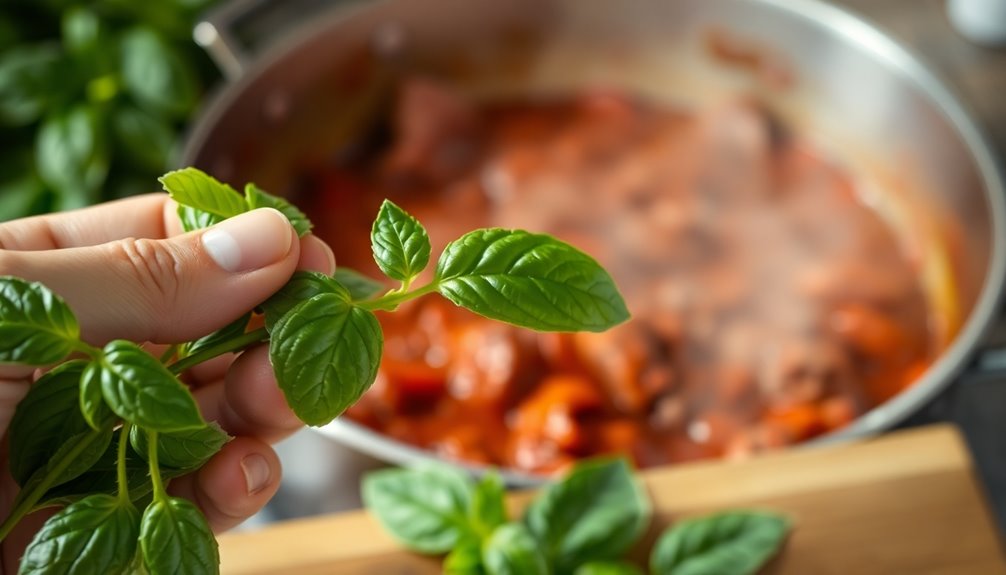
As your sauce nears completion, incorporating fresh basil leaves will elevate the flavor profile significantly. Add about 1/4 to 1/2 cup of loosely packed fresh basil, depending on your taste preference, to enhance the herbal note in your spaghetti sauce.
Tear the leaves by hand to release their essential oils, preserving their vibrant aroma and preventing oxidation. Stir in the fresh basil just 5 minutes before serving, allowing them to wilt slightly without losing their fresh taste.
For an extra burst of flavor, consider using a small amount of fresh basil as a garnish on top of your finished dish. This simple step will transform your spaghetti sauce into a fragrant, delicious masterpiece.
Final Thoughts

While preparing homemade spaghetti sauce might seem daunting, it's actually a quick and fulfilling way to elevate your weeknight dinners.
In about 40 minutes, you can whip up a delicious sauce using pantry staples like ground beef, tomato sauce, onions, and garlic.
Simmering the sauce for at least 30 minutes enhances the flavor, allowing all the ingredients to meld beautifully.
Plus, you can easily customize your sauce with variations, whether you prefer a meatless marinara or a robust meat sauce.
Don't forget about the convenience of leftovers; your homemade spaghetti sauce can be refrigerated for 3-4 days or frozen for 4-6 months, making it a practical choice for future meals.
Enjoy your delicious creation!
